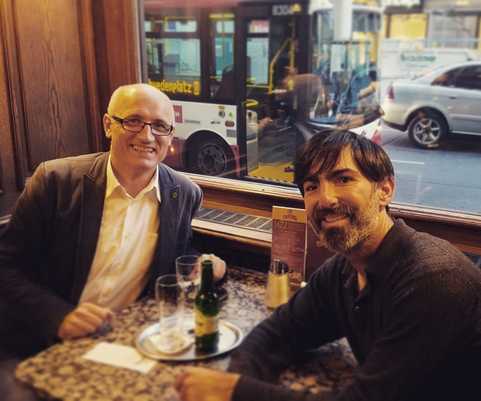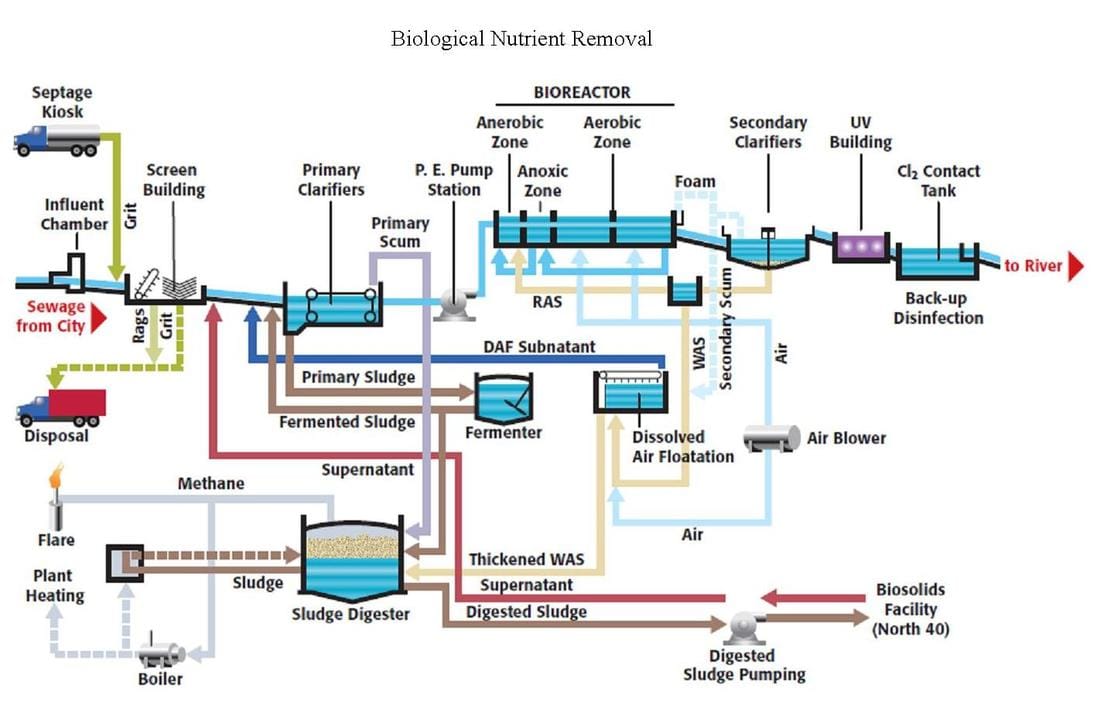|
After meeting Marco Hartl at EU-ISMET in Rome and then visiting the lab in Barcelona, he suggested I visit his previous professor, Thomas Ertl in Vienna, Austria. Vienna is the city in which he studied his undergraduate degree at University of Natural Resources and Life Sciences (BOKU). In addition, Marco also had an old flat mate named Heinz that was very happy to host me during my time in Vienna. Also, in Vienna, at TU Wien, is the office of Helmut Kroiss- the president of the International Water Association (IWA) that gave a keynote lecture atAP-ISMET in Busan, South Korea. Although Helmut no longer holds his office as dean at TU Wien, he was more than delighted to introduce me to Jörg Krampe, the current dean. I also had the opportunity to check out the beautiful architecture in Vienna, visit Freud’s working quarters, enjoy homecooked meals with the locals, and see how the city is turning garbage into sustainable energy.
Jörg Krampe is not your typical research scientist with the title of Dean. Jörg prides himself mainly not on his ability to publish research papers, but instead on his ability to implement and commercialize solutions to water issues in his local and global community. For example, he has worked with the local wastewater treatment plant (WWTP) of Wörgl-Kirchbichl which located on the bank of the river Inn in the municipality of Kirchbichl in Tirol, Austria. With Wörgl-Kirchbichl, Jörg is looking for ways to reduce the amount of aeration needed to treat wastewater by moving towards a more anaerobic wastewater treatment process. This is important because aeration is the leading cost of wastewater treatment worldwide. To read more about it, visit PowerStep or download information here.
In the lab Jörg understands the importance of hands-on student interaction and practical training for jobs at wastewater treatment plants. This is why he has used a significant portion of his lab space to develop a wastewater treatment plant that is controlled and operated just like a large scale wastewater treatment plant. In this lab space, his students have the ability to control the WWTP by manipulated a computer interface that is identical to the ones used at large scale WWTPs.
Next, I took a short train ride to the University of Natural Resources and Life Sciences (BOKU) where I gave a lecture to the class of Thomas Ertl. For this lecture, I spoke about microbial electrochemistry and microbial electrochemical cells (MXCs) as a means for energy recovery from agricultural wastes. After the lecture, we had a brief discussion about where in a wastewater treatment process is thebest place to install a microbial electrochemical cell. This is a topic of debate since the location at which an MXC is implemented in a wastewater treatment plant (WWTP) depends upon the desired outcome.
There are some areas of WWTPs where installing an MXC is clearly a bad idea- but there are also many areas where the choice is not so clear. For example, should we place an MXC at the end to help digest the left over sludge? If we do this, we may impact the market if biosolids used for fertilizer. We may also get low yields since many things left over at the end are very difficult to degrade. However, an MXC may enhance energy recovery and degradation. Perhaps a better option is to put the MXC at the beginning to extract as much energy from the waste as possible. But then we must consider how extracting the energy at the beginning, energy which is used by other processes for biological nutrient removal, affects the rest of the WWTP. Or perhaps using MXCs at WWTP makes no sense no matter where you place it because the wastewater is too unpredictable and diverse. You can see how even the questions of where to implement an MXC becomes a big challenge. If you like the challenge, I suggest visiting this link and reading through the several research institutions featured on this blog!
Directly after the lecture, I was introduced to Dr. Roland Ludwig and his students Christopher Schulz and Alfons Felice. We got together over coffee for a chat about philosophy and then I was given a tour of the lab. In the lab, Christopher Schulz is using electrochemistry to determine the optimal coating method for his electrodes. On this day, he was conducting a parallel calibration experiment using eight amperometric glucose biosensors connected to a multi-potentiostat. The biosensors were built by using screen-printed carbon paste electrodes and an enzyme highly specific for glucose. Alfons did not have any experiments to show me, but he was studying fundamental electron transfer mechanisms in key enzymes (dehydrogenases) which are responsible for breaking down complex wastes during a wastewater treatment or bio-refining process. Both of these projects are connected to the broader context of enhancing wastewater treatment by looking for ways to improve and understand the process at increasingly fundamental levels.
Thomas and I met up later that week to have some drinks at a local bar called Gasthaus. Thomas wanted to introduce me to Andreas Weingartner, the owner of a company called S::CAN. S::CAN is a company that sells low-cost water probes to enable fast and reliable water quality analysis around the globe. From the website:
“The goal of quality monitoring various natural waters and drinking waters is the reduction of harmful effects to our environment and our human health. This aim has to fulfill various guidelines that are defined in official ecological and drinking water quality regulations. Because of the continuous efforts to improve the quality of natural waters, to reduce the health risks of water consumers and to optimise the efficiency of drinking water treatment, the requirements for process technology and for quality control of water are ever increasing. Therefore reliable monitoring stations that provide continuous data are an essential component in the drinking water supply and the environmental protection - both for the dynamic process control as well as for continuous monitoring of the water quality. In environmental monitoring as well as in drinking water production s::can monitoring stations have been in use for many years. Their technological and methodological quality standards have set new boundaries with regards to measurement performance and have often opened up completely new opportunities for drinking water security and environmental protection.”
Not too far from BOKU campus is an interesting looking building. Caught somewhere between a melted candle and a Tim Burton wet dream is Spittelau Energy World from Wien Energie. Designed in the late 20th century by Friedensreich Hundertwasser, "Müllverbrennungsanlage Spittelau" is a facility which converts unrecyclable garbage into renewable energy by literally incinerating it. This facility has the capacity to burn ~17 tons of garbage per hour, producing some six megawatts of electricity and 60 megawatts of heat - which is directly used for the Fernwärme heating system of the city. Facilities like this are essential in Vienna since they have a strict ban on landfills. To facilitate the process, Vienna has at least six different ‘trash’ categories including: organic, paper, glass, plastic, metal, and electronic. The video below shows how a similar process is also taking place in Paris, France.
Just around the corner from Müllverbrennungsanlage Spittelau is a waterfront that has a lot of very interesting and sophisticated street art.
Vienna is the city in which Sigmund Freud, the father of modern psychology, began a private practice to treat hysteria in 1886. Here, Freud developed a theory that humans have an unconscious in which sexual and aggressive impulses are in perpetual conflict for supremacy. In 1897, he began an intensive analysis of himself. He argued that the human psyche is composed of three primary parts; the id, ego and superego. The id, or it, is all of the biological instincts with which we are born- reproduction, consumption, etc… Think about a child, it cries when it wants something it needs and expects to receive what it desires regardless of the world around it. The ego, or I, is the self that perceives the world and determines what interactions are realistic to receive the desires of the id. Lastly, it the super ego, or Above I, in which an individual incorporates the values and moral of society into their world view and considers them when making decisions. In 1900, his major work 'The Interpretation of Dreams' was published in which Freud analysed dreams in terms of unconscious desires and experiences.
The flat in which I was staying was very social. Every night, people were over to share food and wine. For most nights, a former theatre director named Marc Gunther prepared meals. I offered to cook one night and just like that everyone was eating guacamole, salsa, fajitas, and strawberry pie with a no-bake walnut, coconut, and date crust! Marc and I visited a local market (Naschmarkt) to get fresh ingredients. You can see pictures of the extensive market at the end of the blog. But first, given that I am in Vienna and talked eitherlife philosophy or research philsophy to almost everyone I met in Viennesse cafes, I thought it would be cool to share a little philosophy blurb I wrote about knowledge nearly eight years ago:
“I guess the most important thing I have learned in my life is that there is no such thing as control. People try to control things all the time; make plans, save money, invest, but nothing is a sure bet. Knowledge is such a peculiar thing. Humanity’s perception of knowledge often contradicts the fundamental way in which individuals attain new information. People develop opinions, beliefs, (knowledge) etc... on the facts of today which very often become the fictions of tomorrow. An individual who makes the conscious decision to change the beliefs they once held in the past because of the information they have acquired in the present is often perceived as weak in character or two-faced. For fear of losing face, people seem to hold their traditional beliefs despite evidence of the contrary; however, this method for conserving the self often leads to destructive or self-immolating ideas/lifestyles. This fallacious and contradictory judgment of character needs to be altered.
As confusing as it may seem to embrace something one week and detest it the next, this remains the only philosophy that makes sense. Humanity is aware that the Earth spins, is spherical, and is not at the center of a perfectly spherical universe despite strongly routed beliefs held prior to these realizations based on the soundest logic of the time. When someone makes an idea today based on the facts at their disposal, they are truly taking a gamble. Every decision people make, every time people try to control their destiny; they are taking a risk. Whether the risk pays well or yields a deleterious result is beyond the scope of the present and can only be judged by the merits of tomorrow. Individuals who cry foul in hindsight are often mistaken and unjustified in their attempts to deface those whom did the best they could with what they had at their disposal. The facts used to judge the best possible decision made yesterday, and hour ago, five minutes ago are more numerous than those available at the time of the decision. It is never too late for one to change their mind, build their knowledge, and accept that many of the ideas of the past simply do not work in the present. I suggest humanity quit trying to control the present by advocating the false ideas of the past and embrace knowledge as it unwinds every moment of existence. Let us all learn that knowledge is not static, but constantly changing, and that facts are only facts because we have yet learned to know better.” -Bradley Lusk (June 2009)
0 Comments
Leave a Reply. |
Science /ˈsīəns/
|



 RSS Feed
RSS Feed